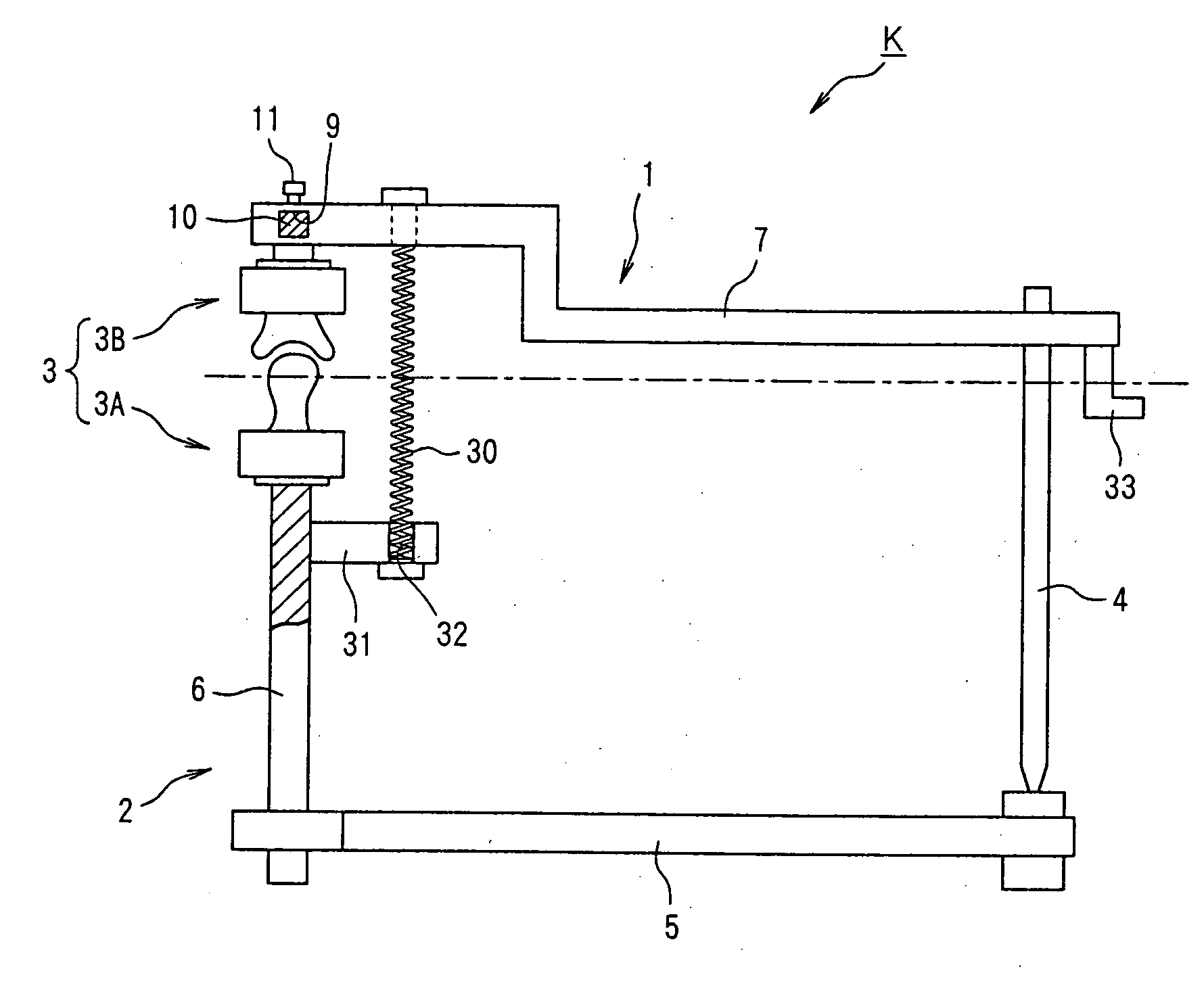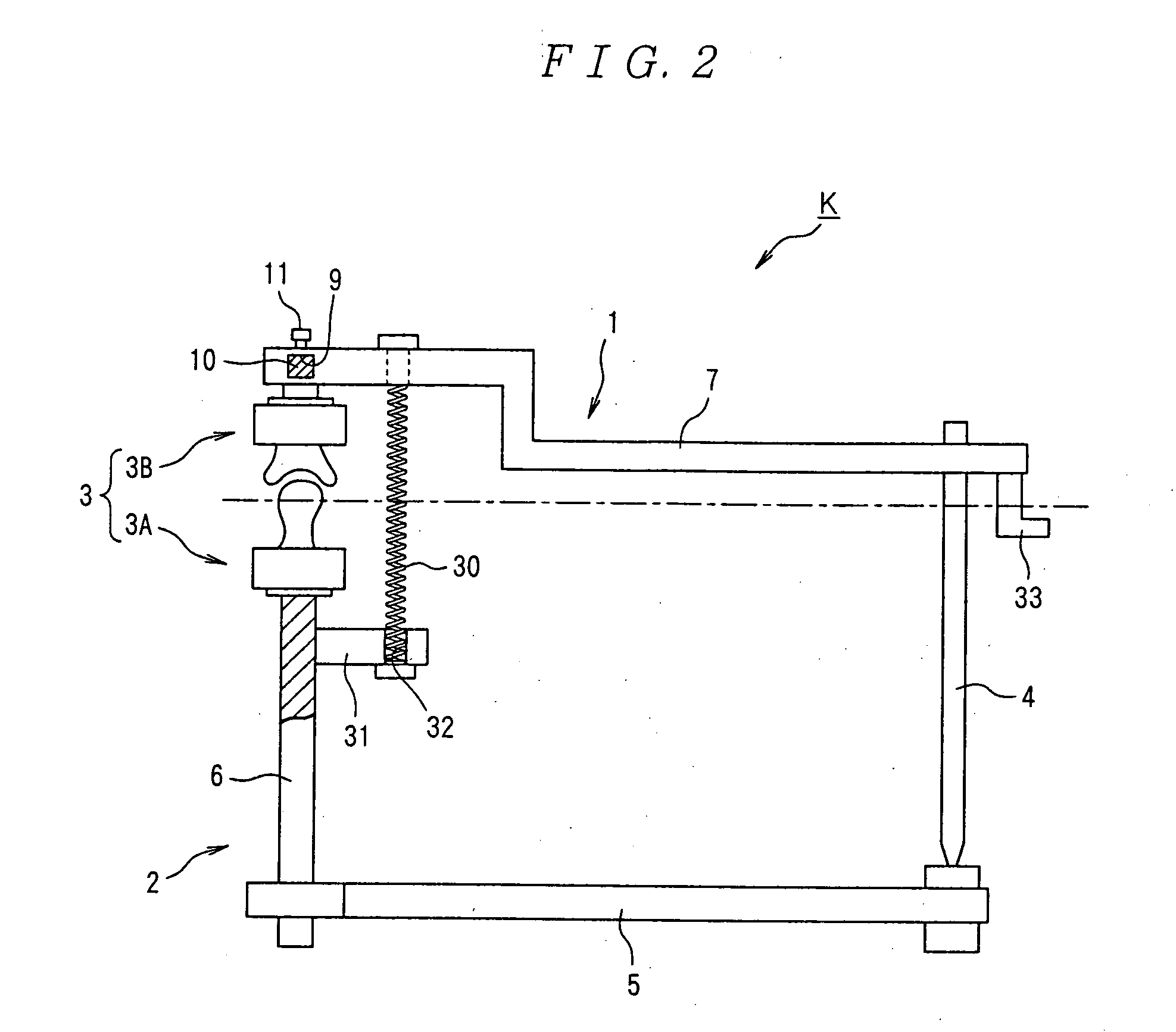Occludator, face bow, occlusion-confirming system and temporomandibular joint-reproducing system
a technology of occludator and occlusion, which is applied in the field of occludator, face bow, occlusionconfirming system and temporomandibular jointreproducing system, can solve the problems of less adjustment, inevitably occurring errors in mandibular movements reproduced by semi-adjustable occludators, and the possibility of prosthesis failure due to any of these errors
- Summary
- Abstract
- Description
- Claims
- Application Information
AI Technical Summary
Benefits of technology
Problems solved by technology
Method used
Image
Examples
embodiment 1
[0155] Embodiment 1 of the present invention will be described below in accordance with the accompanying drawings.
[0156] First, the following will discuss the configuration of an occludator K used for the present system.
[0157] As shown in FIGS. 1 and 2, the occludator K of the present embodiment is constituted of an upper bow-shaped part 1, a lower bow-shaped part 2, a joint 3 for connecting the upper bow-shaped part 1 and the lower bow-shaped part 2, and an incisal pin 4. To enhance understanding, a mandibular condyle model 14 and a maxillary fossa model 22, which are vertically opposed to each other, are not in contact with each other in some drawings below. In reality, the models are in contact with each other (contact state) or an elastic sheet material (not shown, the material is made of a material such as silicon and is preferably equal in elastic modulus to an articular disk) equal in thickness to a gap between joints is interposed between the models. Further, to enhance und...
embodiment 2
[0262] Embodiment 2 will be described below in accordance with the accompanying drawings. The same components as the above-described embodiment will be indicated by the same reference numerals and characters.
[0263] The basic configuration of Embodiment 2 is similar to that of Embodiment 1. A face bow F and a part of an occludator that corresponds to the face bow F are different from those of Embodiment 1.
[0264] First, the configuration of the face bow F of the present embodiment will be discussed below.
[0265] As shown in FIGS. 25 to 27, in the body of the face bow F, legs 100 on the right and left are symmetrically opposed to each other. Each of the legs 100 is shaped like a letter L in plan view. The leg 100 is constituted of a leg body 101 which stretches to the front and rear and a platy horizontal part 102 which is connected to the base of the leg body 101 and stretches to the other opposed leg 100.
[0266] As shown in FIG. 26, the right and left horizontal parts 102 are vertic...
embodiment 3
[0291] Embodiment 3 will be described below in accordance with the accompanying drawings. The same members as the above-described embodiments will be indicated by the same reference numerals and characters.
[0292] The basic configuration of Embodiment 3 is similar to that of Embodiment 2. A face bow F is different from that of Embodiment 2.
[0293] Referring to FIGS. 33 to 35, the face bow F of the present embodiment will be discussed below.
[0294] As with Embodiment 2, right and left legs 100 of the present embodiment are shaped like letters L in plan view, and right and left horizontal parts 102 are vertically overlaid on the other. However, in the present embodiment, a long opening stretching in a lateral direction is formed in each of the horizontal parts 102. The horizontal parts 102 are guided by a box 122 so as to move only in the lateral direction. The top plate and the bottom plate of the box 122 have tapped holes in positions vertically opposed to the long openings formed in...
PUM
 Login to View More
Login to View More Abstract
Description
Claims
Application Information
 Login to View More
Login to View More - R&D
- Intellectual Property
- Life Sciences
- Materials
- Tech Scout
- Unparalleled Data Quality
- Higher Quality Content
- 60% Fewer Hallucinations
Browse by: Latest US Patents, China's latest patents, Technical Efficacy Thesaurus, Application Domain, Technology Topic, Popular Technical Reports.
© 2025 PatSnap. All rights reserved.Legal|Privacy policy|Modern Slavery Act Transparency Statement|Sitemap|About US| Contact US: help@patsnap.com



